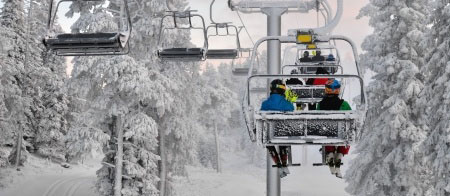|
The temperature is falling and the days are getting shorter, and in my mind that only means one thing – ski season will be starting soon. I have hit the ski and snowboard sales and swaps so my equipment is ready, but how can I get my body ready for that first day one the hill? Knee injuries are very common with skiing. Many sites and bloggers will talk about quads and hamstrings, and how to prep them for the season. Although strength and power are critical, there are a few more things that need to be considered.
Alignment Stand in front of a mirror on one leg. Bend your knee to about 45 degrees with your weight on your heels. You should feel like you are sitting in a chair. Are you able to keep you kneecap directly above your toes? Often knees will drift inwards towards midline. If this occurs it may be your hip that needs strengthening, not your thigh muscles. You can do squats for days and it won’t make the correct muscle stronger. Skiing in this position can increase the stress on the medial, or inner, structures of the knees placing your MCL or meniscus at risk. The clam is a classic exercise to address this problem. Lie on your side with your hips relatively straight and your knees bent to 45 degrees. Tighten your lower abdominal muscles. Slowly raise the top knee while keeping your ankles touching. Focus on tightening your gluts and rolling your hip. You should feel the area of your back pocket working. Start by doing 3 sets of 15 to 20. How your muscles are working When skiing, the quads and the hamstrings work not only to create movement but also to control the speed of movement against momentum or gravity. For example, the hamstring can bend the knee during a step turn, but it also prevents the knee from snapping straight, or straightening too far during a fall. This eccentric strength of the hamstrings has been shown to decrease the rate of ACL injuries of the knee. A Norwegian hamstring curl can increase eccentric strength of the knees. Kneel facing away from a partner, with your hands crossed at chest level. Have your partner hold your feet at the ankles to prevent them from lifting off the ground. Keeping your back and hips straight, slowly straighten your knees to lower your body to the floor. Eventually you will lose control, fall forward on your hands into a push up position. Push up with your arms to return to the starting position. Start with three sets of 5-8 repetitions. Proprioception Proprioception is the body ability to know where it is in space without looking. To improve this work on simple balance exercises. For example, stand on one foot for thirty seconds a couple of times per day. If that becomes easy, try it with your eyes closed or while you toss and catch a tennis ball. Like your skis, make sure that you are finely tuned for the first day on the slope. Prevention is key. If you are concerned about joint aches and muscle pain, make sure to see a physician or physiotherapist before injury happens.
0 Comments
Your comment will be posted after it is approved.
Leave a Reply. |
Physio Sport Med
Serving all of Oakville in the Uptown / Dundas-Trafalgar Core. Archives
May 2025
Categories |
- Info
- Book Now
-
Team
-
How We Treat
- Sport Medicine Consultation
- Manual - Exercise Physio
- Sport Physiotherapy
- Tissue Injections
- Acupuncture
- Vestibular Physiotherapy
- Osteopathy
- Chiropractic Care
- Concussion Program
- Shockwave Therapy
- Female Pelvic Health
- Male Pelvic Health
- Registered Massage Therapy
- Nutrition Consultation
- On-Field Therapy Coverage
- Custom Orthotics
-
What We Treat
- Sports Injuries
- Low Back Pain
- Osteoarthritis
- Motor Vehicle Accident
- Sprains
- Muscle Strains
- Concussion
- Rotator Cuff
- Tendonitis
- Neck Pain and Headaches
- Hip Pain
- Shoulder Pain
- Elbow, Wrist and Hand Pain
- Foot and Ankle Pain
- Post Surgical Rehabilitation
- Gait and Balance Disorders
- Knee Injuries
- Pelvic Floor Conditions
- Blog


 RSS Feed
RSS Feed